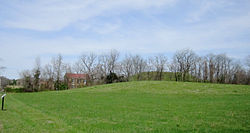Fewkes Group Archaeological Site

Fewkes Mounds No. 1 & 2. Boiling Spring Academy in the background
|
|
| Location |
Williamson County, Tennessee, |
|---|---|
| Region | Williamson County, Tennessee |
| Coordinates | 35°58′0.44″N 86°46′34.54″W / 35.9667889°N 86.7762611°W |
| History | |
| Founded | 1050 |
| Abandoned | 1475 |
| Cultures | Mississippian culture |
| Site notes | |
| Excavation dates | 1920 |
| Archaeologists | William E. Myer |
| Architecture | |
| Architectural styles | burial mounds, platform mounds, plaza |
| Responsible body: City of Brentwood | |
Fewkes Group Archaeological Site (40 WM 1), also known as the Boiling Springs Site, is a prehistoric Native American archaeological site located in the city of Brentwood, in Williamson County, Tennessee. It is in Primm Historic Park on the grounds of Boiling Spring Academy, a historic schoolhouse established in 1830. The 15-acre site consists of the remains of a late Mississippian culture mound complex and village roughly dating to 1050-1475 AD. The site, which sits on the western bank of the Little Harpeth River, has five mounds, some used for burial and others, including the largest, were ceremonial platform mounds. The village was abandoned for unknown reasons around 1450. The site is named in honor of Dr. J. Walter Fewkes, the Chief of the Bureau of American Ethnology in 1920, who had visited the site and recognized its potential. While it was partially excavated by the landowner in 1895, archaeologist William E. Myer directed a second, more thorough excavation in October 1920. The report of his findings was published in the Bureau of American Ethnology’s Forty-First Annual Report. Many of the artifacts recovered from the site are now housed at the Smithsonian Institution. It was added to the National Register of Historic Places on April 21, 1980, as NRIS number 80003880.
Two different groups of people lived at the Fewkes Site. The first group, who built the mounds and left the majority of artifacts, buried their dead with their bodies tightly flexed in hexagonal and circular stone box graves. This was probably achieved by tightly binding the body after death, because the bones appear to be in their proper places. These people appear to have lived in circular houses. This occupation dates to the Mississippian period, between 1000 – 1450. A second group moved into the area toward the end of the period. This group buried its dead with the bodies fully extended, on their backs, in rectangular stone box graves. Archaeological research done within the Middle Cumberland River Valley marks a virtual abandonment of the area around 1450. It is unknown what caused this, but the large amount of broken pottery on the floors of their homes may indicate that they were forced to leave in a hurry. This abandonment of the region is part of a larger pattern seen in parts of the Ohio, Mississippi, Tennessee, and Cumberland River valleys known as the “Vacant Quarter” hypothesis. As of 2010, officials at the Tennessee Department of Environment and Conservation, Division of Archaeology, have been unable to identify modern tribal descendants of the inhabitants of the site.
...
Wikipedia

